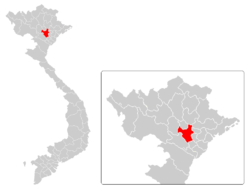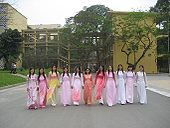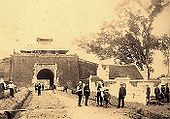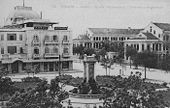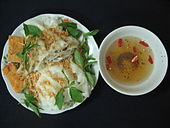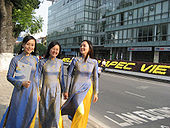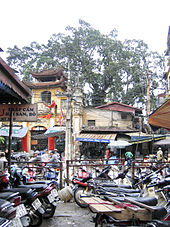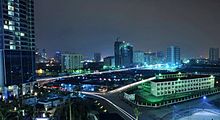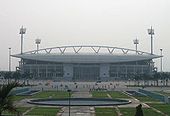
Hanoi
Background Information
This Wikipedia selection is available offline from SOS Children for distribution in the developing world. SOS mothers each look after a a family of sponsored children.
| Hà Nội Thành phố Hà Nội |
|||
|---|---|---|---|
| — Municipality — | |||
| (from left) top: Long Bien Bridge, river near Perfume Pagoda; middle: Turtle Tower, bottom: Temple of Literature, Ho Chi Minh Mausoleum, Hanoi Opera House | |||
|
|||
| Provincial location in Vietnam | |||
| Coordinates: 21°2′0″N 105°51′00″E Coordinates: 21°2′0″N 105°51′00″E | |||
| Country | |||
| Central city | Hanoi | ||
| Founded, Capital of the Đại Việt | 1010 | ||
| Capital of Vietnam | September 2, 1945 | ||
| Demonym | Hanoians | ||
| Government | |||
| • Party's Secretary (Bí thư Thành ủy) | Phạm Quang Nghị | ||
| • People's Council's President (Chủ tịch Hội đồng Nhân Dân) | Ngô Thị Doãn Thanh | ||
| • People's Committee's President (Chủ tịch Ủy ban Nhân Dân) | Nguyễn Thế Thảo | ||
| Area | |||
| • Municipality | 3,344.7 km2 (1,291.4 sq mi) | ||
| • Urban | 186.22 km2 (71.90 sq mi) | ||
| Population (2009) | |||
| • Municipality | 6,500,000 | ||
| • Rank | 2nd in Vietnam | ||
| • Density | 1,900/km2 (5,000/sq mi) | ||
| Time zone | ICT ( UTC+7) | ||
| Website | hanoi.gov.vn | ||
Hà Nội (Hà Nội; listen), is the capital of Vietnam and the country's second largest city. Its population in 2009 was estimated at 2.6 million for urban districts, 6.5 million for the metropolitan jurisdiction. From 1010 until 1802, it was the most important political centre of Vietnam. It was eclipsed by Huế, the imperial capital of Vietnam during the Nguyen dynasty (1802-1945), but Hanoi served as the capital of French Indochina from 1902 to 1954. From 1954 to 1976, it was the capital of North Việt Nam, and it became the capital of a reunified Vietnam in 1976, after the North's victory in the Vietnam war.
The city is located on the right bank of the Red River. Hanoi is located at 1,760 km (1,090 mi) north of Ho Chi Minh City and at 120 km (75 mi) west of Hai Phong city.
October 2010 officially marked 1000 years since the establishment of the city.
The city will host the 2019 Asian Games.
Names
Hanoi ( 河 內) has had many names throughout history, all of them of Sino-Vietnamese origin. During the Chinese domination of Vietnam, it was known first as Long Biên, then Tống Bình ( 宋 平, " Song Peace") and Long Đỗ ( 龍 肚, "Dragonbelly"). In 866, it was turned into a citadel and named Đại La ( 大 羅, "Big Net").
History
Pre-history
Hanoi has been inhabited since at least 3000 BC. One of the first known permanent settlements is the Co Loa citadel founded around 200 BC.
Thăng Long, Đông Đô, Đông Quan, Đông Kinh
In 1010, Ly Thai To, the first ruler of the Lý Dynasty, moved the capital of Đại Việt to the site of the Đại La Citadel. Claiming to have seen a dragon ascending the Red River, he renamed the site Thăng Long ( 昇 龍, "Rising Dragon") - a name still used poetically to this day. Thăng Long remained the capital of Đại Việt until 1397, when it was moved to Thanh Hóa, then known as Tây Đô ( 西 都), the "Western Capital". Thăng Long then became Đông Đô ( 東 都), the "Eastern Capital."
In 1408, the Chinese Ming Dynasty attacked and occupied Vietnam, changing Đông Đô's name to "Eastern Gateway" (Chinese: 東 關, Dōngguān), Đông Quan in Vietnamese. In 1428, the Vietnamese overthrew the Chinese under the leadership of Lê Lợi, who later founded the Lê Dynasty and renamed Đông Quan Đông Kinh ( 東 京, "Eastern Capital") or Tonkin. Right after the end of the Tây Sơn Dynasty, it was named Bắc Thành ( 北 城, "Northern Citadel").
During Nguyễn Dynasty and French colonial
In 1802, when the Nguyễn Dynasty was established and moved the capital to Huế, the old name Thăng Long was modified to become Thăng Long ( 昇 隆, "Ascending & Flourishing"). In 1831, the Nguyễn emperor Minh Mạng renamed it Hà Nội ( 河 内, "Between Rivers" or "River Interior"). Hanoi was occupied by the French in 1873 and passed to them ten years later. As Hanoï, it became the capital of French Indochina after 1887.
During two wars
The city was occupied by the Japanese in 1940 and liberated in 1945, when it briefly became the seat of the Viet Minh government after Ho Chi Minh proclaimed the independence of Vietnam. However, the French returned and reoccupied the city in 1946. After nine years of fighting between the French and Viet Minh forces, Hanoi became the capital of an independent North Vietnam in 1954.
During the Vietnam War, Hanoi's transportation facilities were disrupted by the bombing of bridges and railways. These were all, however, promptly repaired. Following the end of the war, Hanoi became the capital of a reunified Vietnam when North and South Vietnam were reunited on July 2, 1976.
Modern Hanoi
On May 29, 2008, it was decided that Ha Tay Province, Vĩnh Phúc's Mê Linh district and 4 communes of Lương Sơn District, Hoa Binh be merged into the metropolitan area of Hanoi from August 1, 2008. Hanoi's total area then increased to 334,470 hectares in 29 subdivisions with the new population being 6,232,940., effectively tripling its size. The Hanoi Capital Region (Vùng Thủ đô Hà Nội), a metropolitan area covering Hanoi and 6 surrounding provinces under its administration, will have an area of 13,436 square kilometers with a population of 15 million by 2020
Geography
Location, topography
Climate
Hanoi features a warm humid subtropical climate ( Köppen Cwa) with plentiful precipitation. The city experiences the typical climate of northern Vietnam, where summers are hot and humid, and winters are, by national standards, relatively cold and dry. Summers, lasting from May to September, are hot and humid, receiving the majority of the annual 1,680 millimetres (66.1 in) of rainfall. The winters, lasting from November to March, are relatively mild, dry (in the first half) or humid (in the second half), while spring (April) can bring light rains. It is important to note that particularly around the Halong Bay region in these months, it can get particularly cold. Autumn (October) is the best time of year in term of weather. The city is usually cloudy and foggy in the winter time with average monthly sunshine hours for February are only 1.8 h/day.
Extreme temperatures have ranged from 2.7 °C (36.9 °F) to 40.4 °C (105 °F).
| Climate data for Hanoi (1898-1990) | |||||||||||||
|---|---|---|---|---|---|---|---|---|---|---|---|---|---|
| Month | Jan | Feb | Mar | Apr | May | Jun | Jul | Aug | Sep | Oct | Nov | Dec | Year |
| Record high °C (°F) | 33 (91) |
34 (93) |
37 (99) |
39 (102) |
43 (109) |
40 (104) |
40 (104) |
38 (100) |
37 (99) |
36 (97) |
36 (97) |
37 (99) |
43 (109) |
| Average high °C (°F) | 19.3 (66.7) |
19.9 (67.8) |
22.8 (73) |
27.0 (80.6) |
31.5 (88.7) |
32.6 (90.7) |
32.9 (91.2) |
31.9 (89.4) |
30.9 (87.6) |
28.6 (83.5) |
25.2 (77.4) |
21.8 (71.2) |
27.0 (80.6) |
| Daily mean °C (°F) | 16.5 (61.7) |
17.5 (63.5) |
20.5 (68.9) |
24.2 (75.6) |
27.9 (82.2) |
29.2 (84.6) |
29.5 (85.1) |
28.8 (83.8) |
27.8 (82) |
25.3 (77.5) |
21.9 (71.4) |
18.6 (65.5) |
24.0 (75.2) |
| Average low °C (°F) | 13.7 (56.7) |
15.0 (59) |
18.1 (64.6) |
21.4 (70.5) |
24.3 (75.7) |
25.8 (78.4) |
26.1 (79) |
25.7 (78.3) |
24.7 (76.5) |
21.9 (71.4) |
18.5 (65.3) |
15.3 (59.5) |
20.9 (69.6) |
| Record low °C (°F) | 3 (37) |
5 (41) |
7 (45) |
10 (50) |
16 (61) |
21 (70) |
22 (72) |
21 (70) |
17 (63) |
13 (55) |
6 (43) |
5 (41) |
3 (37) |
| Rainfall mm (inches) | 18.6 (0.732) |
26.2 (1.031) |
43.8 (1.724) |
90.1 (3.547) |
188.5 (7.421) |
239.9 (9.445) |
288.2 (11.346) |
318.0 (12.52) |
265.4 (10.449) |
130.7 (5.146) |
43.4 (1.709) |
23.4 (0.921) |
1,676.2 (65.991) |
| Avg. rainy days | 8.4 | 11.3 | 15.0 | 13.3 | 14.2 | 14.7 | 15.7 | 16.7 | 13.7 | 9.0 | 6.5 | 6.0 | 144.5 |
| % humidity | 78 | 82 | 83 | 83 | 77 | 78 | 79 | 82 | 79 | 75 | 74 | 75 | 78.8 |
| Mean monthly sunshine hours | 93 | 56 | 62 | 120 | 186 | 180 | 186 | 186 | 180 | 155 | 150 | 124 | 1,678 |
| Source #1: World Meteorological Organisation (UN), BBC Weather (record highs, lows, and humidity) | |||||||||||||
| Source #2: World Climate Guide | |||||||||||||
Education
Hanoi, as the capital of French Indochina, was home to the first Western-style universities in Indochina, including: Indochina Medical College (1902) - now Hanoi Medical University, Indochina University (1904) - now Hanoi National University, and École Supérieure des Beaux-Arts de L'Indochine (1925) - now Hanoi University of Fine Art.
After the Communist Party took control over Hanoi in 1954 with support from the Soviet Union, many new universities were built, among them, Hanoi University of Technology remains the largest technical university in Vietnam.
Hanoi is the largest centre of education in Vietnam. It is estimated that 62% of the scientists in the whole country are living and working in Hanoi. Admissions to undergraduate study are through entrance examinations, which are conducted annually and open for everyone (who has successfully completed his/her secondary education) in the country. The majority of universities in Hanoi are public, although in recent years a number of private universities have started their operation. Thăng Long University, founded in 1988, by some Vietnamese mathematics professors in Hanoi and France is the first private university in Vietnam. Because many of Vietnam's major universities are located in Hanoi, students from other provinces (especially in the northern part of the country) wishing to enter university often travel to Hanoi for the annual entrance examination. Such events often take place in June and July, during which a large number of students and their families converge on the city for several weeks around this intense examination period. In recent years, these entrance exams have been centrally coordinated by the Ministry of Education, but passing marks are decided independently by each university.
Although there are state owned kindergartens, there are also many private ventures that serve both local and international needs. Pre-tertiary (elementary and secondary) schools in Hanoi are generally state run although there are some independent schools. Education is equivalent to the K–12 system in the US, with elementary school between grades 1 and 5, middle school (or junior high) between grades 6 and 9, and high school from grades 10 to 12.
Landmarks
As the capital of Vietnam for almost a thousand years, Hanoi is considered one of the main cultural centres of Vietnam, where most Vietnamese dynasties have left their imprint. Even though some relics have not survived through wars and time, the city still has many interesting cultural and historic monuments for visitors and residents alike. Even when the nation's capital moved to Huế under the Nguyễn Dynasty in 1802, the city of Hanoi continued to flourish, especially after the French took control in 1888 and modeled the city's architecture to their tastes, lending an important aesthetic to the city's rich stylistic heritage. The city hosts more cultural sites than any city in Vietnam, and boasts more than 1,000 years of history, and that of the past few hundred years has been well preserved.
Old Quarter
The Old Quarter, near Hoan Kiem lake, has the original street layout and architecture of old Hanoi. At the beginning of the 20th century the city consisted of only about 36 streets, most of which are now part of the old quarter. Each street then had merchants and households specialized in a particular trade, such as silk traders, jewellery, etc. The street names nowadays still reflect these specializations, although few of them remain exclusively in their original commerce. The area is famous for its small artisans and merchants, including many silk shops. Local cuisine specialties as well as several clubs and bars can be found here also. A night market (near Đồng Xuân market) in the heart of the district opens for business every Friday, Saturday, and Sunday evening with a variety of clothing, souvenirs and food.
Some others prominent places are: The Temple of Literature (Văn Miếu), site of the oldest university in Vietnam 1010; One Pillar Pagoda (Chùa Một Cột); Flag Tower of Hanoi (Cột cờ Hà Nội). In 2004, a massive part of the 900 year old Hanoi Citadel was discovered in central Hanoi, near the site of Ba Dinh Square.
Lakes
A city between the rivers, built from lowland, Hanoi has many scenic lakes and it is sometimes called "city of lakes". Among its lakes, the most famous are Hoan Kiem Lake, West Lake, Halais Lake (Hồ Thiền Quang in Vietnamese), and Bay Mau Lake. Hoan Kiem Lake, also known as Sword Lake, is the historical and cultural centre of Hanoi, and is linked to the legend of the magic sword. West Lake (Hồ Tây) is a popular place for people to spend time. It is the largest lake in Hanoi and there are many temples in the area. There are swanboats for hire. The lakeside road in Quang An area is perfect for bicycling, jogging and viewing the cityscape especially in the sunset or enjoying lotus ponds in the summer
Colonial Hanoi
Under French rule, as an administrative centre for the French colony of Indochina, the French colonial architecture style became dominant, many examples remain today: the tree-lined boulevards (e.g. Phan Dinh Phung street) and its many villas and mansions, Grand Opera House, State Bank of Vietnam (formerly The Bank of Indochina), Presidential Palace (formerly Palace of the Governor-General of French Indochina), Saint Joseph Cathedral, and the historic Hotel Metropole. Many of the colonial structures are an eclectic mixture of French and traditional Vietnamese architectural styles, such as the National Museum of Vietnamese History, the Vietnam National Museum of Fine Arts and the old Indochina Medical College.
Museums
Hanoi is also home to a number of museums:
- National Museum of Vietnamese History
- Vietnam National Museum of Fine Arts
- Vietnam Museum of Ethnology
- Vietnam Museum of Revolution
- Hanoi Hilton (Hoa Lo Prison)
- Ho Chi Minh Museum
- Contemporary Arts Centre
- Vietnam Military History Museum
- The Hanoi Museum
Tourism
According to TripIndex by TripAdvisor, for period June 1 to August 31, 2012 Hanoi will be the cheapest city in the world for two of a one-night stay in a four-star hotel, cocktails, a two-course dinner with a bottle of wine, and a taxi transport (two return journeys of about 3.2 kilometres each). It will cost of $141.12 or about 27 percent of the most expensive city, London with cost of $518.01.
Entertainment
A variety of options for entertainment in Hanoi can be found throughout the city. Modern and traditional theaters, cinemas, karaoke bars, dance clubs, bowling alleys, and an abundance of opportunities for shopping provide leisure activity for both locals and tourists. Hanoi has been named as one of the top 10 cities for shopping in Asia by Smart Travel Asia. The number of art galleries exhibiting Vietnamese art has dramatically increased in recent years, including galleries such as "Nhat Huy" of Huynh Thong Nhat.
A popular traditional form of entertainment is water puppetry, which is shown for example at the Thăng Long Water Puppet Theatre.
Shopping
With its rapid growth and extremely high population density, several modern shopping centers have been built in Hanoi. Major malls include:
- Trang Tien Plaza, Trang Tien street, Hoan Kiem District
- Vincom Centre, Ba Trieu Street, Hai Ba Trung District
- Parkson Department Store, Tây Sơn Street, Viet Tower, Dong Da District; Landmark Parkson Department Store at Vietnam's tallest building, Hanoi Landmark Tower (Pham Hung Road)
- The Garden Shopping Centre, Me Tri - My Dinh, Tu Liem District
- Pico Mall, MIPEC Tower, Tay Son Street, Dong Da District
- Indochina Plaza, Xuan Thuy street, Cau Giay District
- Royal City Megamall, Nguyen Trai street, Thanh Xuan District (to be opened in July 2013)
Cuisine
Hanoi has rich food traditions and many of Vietnam's most famous dishes, such as phở, chả cá, bánh cuốn and cốm are thought to come from Hanoi. Perhaps most widely known is Phở, a simple rice noodle soup often eaten as a breakfast dish in the home or at streetside cafes, but also served in restaurants as a meal. Two varieties dominate the Hanoi scene: Phở Bò, containing beef, and Phở Gà, containing chicken.
Hanoi has been selected as one of the top 10 cities for food in the world by Shermans Travel. Vietnam's national dish Phở has been also named as one of the Top5 streetfood in the world by globalpost.
Hanoi has a number of restaurants whose menus specifically offer dishes containing snake and various species of insects. Insect inspired menus can be found at a number of restaurants in Khuong Thuong village, Hanoi. The signature dishes at these restaurant are those containing processed ant-eggs, often in the culinary styles of Thai people or Vietnam's Muong and Tay ethnic people.
Population
Hanoi's population is constantly growing (about 3.5% per year), a reflection of the fact that the city is both a major metropolitan area of Northern Vietnam, and also the country's political centre. This population growth also puts a lot of pressure onto the infrastructure, some of which is antiquated and dates back from the early 20th century.
The number of Hanoians who settled down for more than three generations is likely to be very small as compared to the overall population of the city. Even in the Old Quarter, where commerce started hundreds years ago and was mostly a family business, many of the street-front stores nowadays are owned by merchants and retailers from other provinces. The original owner family may have either rented out the store and moved to live further inside the house, or just moved out of the neighbourhood altogether. The pace of change has especially escalated after the abandonment of central-planning economic policies, and relaxing of the district-based household registrar system.
Hanoi's telephone numbers have been increased to 8 digits to cope with demand (October 2008). Subscribers telephone numbers have been changed in a haphazard way; however, mobile phones and SIM cards are readily available in Vietnam, with pre-paid mobile phone credit available in all areas of Hanoi.
Transport
Hanoi is served by Noi Bai International Airport, located in the Soc Son District, approximately 40 km (25 mi) north of Hanoi. Noi Bai is the only international airport for the northern regions of Vietnam.
Hanoi will have additionally another international airport, which will cost $8 billion, being the highest foreign investment so far in the history of Vietnam. The construction will be carried out in three stages,the first phase will start in 2011 until 2015.
There are two main highways linking the airport and city. The route to the city via Thăng Long Bridge is more direct than Highway 1, which runs along the outskirts of the city. The main highways are shared by cars, motor scooters, with separate lanes by the side for bicycles. Taxis are plentiful and usually have trip meters, although it is also common to agree on the trip price before taking a taxi from airport to the city centre. Tourists also sometimes tour the city on cyclos especially in the Old Quarter.
Hanoi is also the origin departure point for many Vietnam Railways train routes in the country. The Reunification Express (tàu Thống Nhất) runs from Hanoi to Ho Chi Minh City from Hanoi station (formerly Hang Co station), with stops at cities and provinces along the line. Trains also depart Hanoi frequently for Hai Phong and other northern cities.The Reunification Express line was established during French colonial rule, and was completed over a period of nearly forty years, from 1899 to 1936. The Reunification Express between Hanoi and Ho Chi Minh City covers a distance of 1726 kilometers and takes approximately 33 hours. As of 2005, there were 278 stations on the Vietnamese railway network, of which 191 were located along the North-South line.
The main means of transport within Hanoi city are motorbikes, buses, taxis, and bicycles. Over the preceding decades, motorbikes have overtaken bicycles as Public buses run on many routes and fare can be purchased on the bus, with very cheap prices (20 cents for a journey where a taxi might cost $10.)
Persons on their own or traveling in a pair who wish to make a fast trip around Hanoi, to avoid traffic jams or to travel at an irregular time or by way of an irregular route, often use "xe ôm" (literally, "hug vehicle") motorbikes, which are unofficial, unregulated motorcycle taxis that involve the passenger sitting on the rear of a motorbike. Idle xe ôm riders often yell "xe ôm" at paedestrians that pass by, and signs saying "xe ôm" adorn many a tree, pole or post around the city (as with all Vietnamese cities, towns and villages,etc.) to advertise that a xe ôm vehicle and rider is often parked there. It is customary to negotiate the price of a xe ôm trip with xe ôm riders. Motorbikes can also be rented from agents within the Old Quarter of Hanoi.
Economy
Hanoi has the highest Human Development Index among the cities in Vietnam.According to a recent ranking by PricewaterhouseCoopers, Hanoi will be the fastest growing city in the world in term of GDP growth from 2008 to 2025.
Industrial production in the city has experienced a rapid boom since the 1990s, with average annual growth of 19.1 percent from 1991–95, 15.9 percent from 1996–2000, and 20.9 percent during 2001–2003. In addition to eight existing industrial parks, Hanoi is building five new large-scale industrial parks and 16 small- and medium-sized industrial clusters. The non-state economic sector is expanding fast, with more than 48,000 businesses currently operating under the Enterprise Law (as of 3/2007).
Trade is another strong sector of the city. In 2003, Hanoi had 2,000 businesses engaged in foreign trade, having established ties with 161 countries and territories. The city's export value grew by an average 11.6 percent each year from 1996–2000 and 9.1 percent during 2001–2003. The economic structure also underwent important shifts, with tourism, finance, and banking now playing an increasingly important role. Hanoi's business districts are traditionally Hoan Kiem and the neighbourhood; and a newly developing Trung Hoa Nhan Chinh in the southwestern part.
Similar to Ho Chi Minh City, Hanoi enjoys a rapidly developing real estate market. The metropolis's economy growth does not seem correlative to its infrastructure. Overloading population requires a much larger supply of accommodations, while the constructing celerities of both transport system and new urban areas are too low. Not surprisingly, as an effect of this problem, the apartment and real estate fever occur severely during the time. More widespread, the fever even influences Ha Tay, the neighboring province, considered the future development space of the capital. The current most notable new urban areas are central Trung Hoa Nhan Chinh, My Dinh, the luxurious zones of The Manor and Ciputra.
Agriculture, previously a pillar in Hanoi's economy, has striven to reform itself, introducing new high-yield plant varieties and livestock, and applying modern farming techniques.
Together with economic growth, Hanoi's appearance has also changed significantly, especially in recent years. Infrastructure is constantly being upgraded, with new roads and an improved public transportation system.
On February 2013 Dubai-based property developer Global Sphere announced a mega-project to build about 70 residential towers in Hanoi in an area dubbed the Hanoi Wall Street. . The first phase, valued at $10 billion, is expected to be finished by 2020.
Sport centers
There are several gymnasiums and stadiums throughout the city of Hanoi. The biggest ones are My Dinh National Stadium ( Le Duc Tho Boulevard), Quan Ngua Sporting Palace ( Van Cao Avenue), Hanoi Aquatics Sports Complex and My Dinh Indoor Athletics Gymnasium. The others include Hà Nội Stadium (as known as Hàng Đẫy stadium). The third Asian Indoor Games was held at Hanoi in 2009. The others are Hai Bà Trưng Gymnasium, Trịnh Hoài Đức Gymnasium, Vạn Bảo Sports Complex.
Health care and other facilities
Some medical facilities in Hanoi:
- Bach Mai Hospital
- Viet Duc Hospital
- Saint Paul Hospital
- 108 Hospital
- L'Hôpital Français De Hanoï
- International SOS
Districts
Hanoi is divided into 10 inner districts, 1 town and 18 outer districts. ( Hà Đông has been transform to an inner district, and Sơn Tây has been degraded to a town)
| Subdivisions of Hanoi | ||||
|---|---|---|---|---|
| Provincial Cities/Districts | Wards | Area (km2) | Population | |
| 1 town | ||||
| Sơn Tây | 15 | 113.474 | 181,831 | |
| 10 Urban Districts (Quận) | ||||
| Ba Đình | 14 | 9.224 | 228,352 | |
| Cầu Giấy | 8 | 12.04 | 147,000 | |
| Đống Đa | 21 | 9.96 | 352,000 | |
| Hai Bà Trưng | 20 | 14.6 | 378,000 | |
| Hà Đông | 17 | 47.917 | 198,687 | |
| Hoàn Kiếm | 18 | 5.29 | 178,073 | |
| Hoàng Mai | 14 | 41.04 | 216,277 | |
| Long Biên | 14 | 60.38 | 170,706 | |
| Tây Hồ (West Lake) | 8 | 24 | 115,163 | |
| Thanh Xuân | 11 | 9.11 | 185,000 | |
| Subtotal | 145 | 233.56 | 2,178,258 | |
| 18 Rural Districts (Huyện) | ||||
| Ba Vì | 31 + 1 town | 428.0 | 242,600 (1999) | |
| Chương Mỹ | 30 + 2 towns | 232.9 | 261,000 (1999) | |
| Đan Phượng | 15 + 1 town | 76.8 | 124,900 | |
| Đông Anh | 23 + 1 town | 182.3 | 276,750 | |
| Gia Lâm | 20 + 2 towns | 114.0 | 205,275 | |
| Hoài Đức | 19 + 1 town | 95.3 | 188,800 | |
| Mê Linh | 16 + 2 towns | 141.26 | 187,536 (2008) | |
| Mỹ Đức | 21 + 1 town | 230.0 | 167,700 (1999) | |
| Phú Xuyên | 26 + 2 towns | 171.1 | 181,500 | |
| Phúc Thọ | 25 + 1 town | 113.2 | 154,800 (2001) | |
| Quốc Oai | 20 + 1 town | 136.0 (2001) | 146,700 (2001) | |
| Sóc Sơn | 25 + 1 town | 306.51 | 254,000 | |
| Thạch Thất | 22 + 1 town | 128.1 | 149,000 (2003) | |
| Thanh Oai | 20 + 1 town | 129.6 | 142,600 (1999) | |
| Thanh Trì (Green Ponds) | 15 + 1 town | 98.22 | 241,000 | |
| Thường Tín | 28 + 1 town | 127.7 | 208,000 | |
| Từ Liêm | 15 + 1 town | 75.32 | 240,000 | |
| Ứng Hòa | 28 + 1 town | 183.72 | 193,731 (2005) | |
| Subtotal | 399 + 22 towns | 3,266.186 | 3,872,851 | |
| Total | 559 + 22 towns | 3,344.47 | 6,232,940 | |
International relations
Twin towns and sister cities
Hanoi is twinned with:


